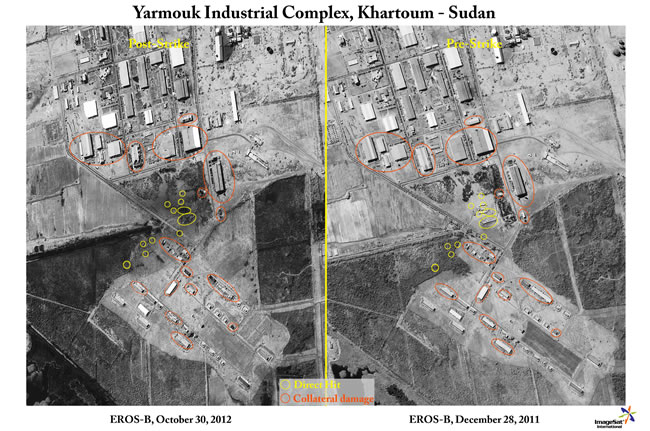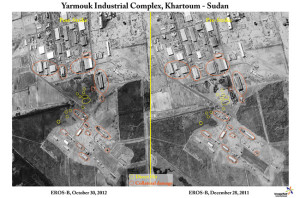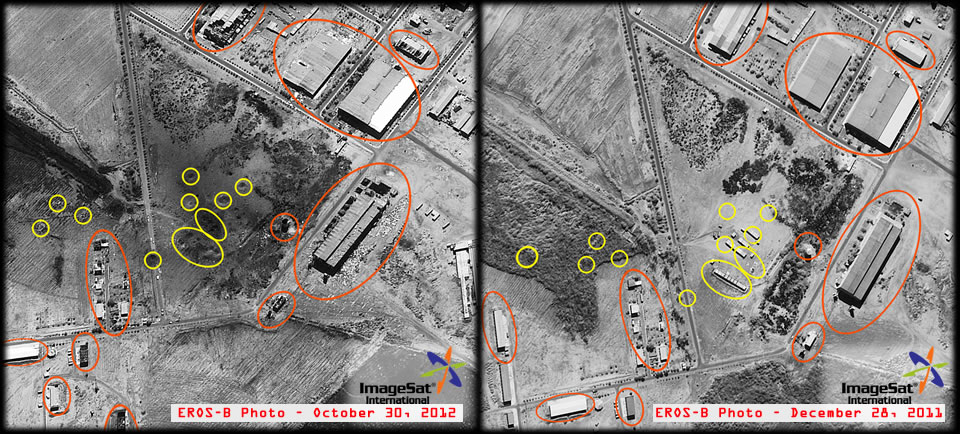

A powerful explosion at the Yarmuk military factory rocked Sudan’s capital before dawn, sending detonating ammunition flying through the air and causing panic, the Sudan official news agency and local media reports said. Thick black smoke covered the sky over the Military Industrial Complex in southern Khartoum. Sudan’s media reported that nearby buildings were damaged by the blast, their roofs blown off and their windows shattered. The effects of the blast suggested a “highly volatile cargo” was at the epicenter of the explosion.
The Sudanese minister who immediately accused Israel of carrying out an aerial strike on a weapons factory near Khartoum apparently knew what he was talking about. Although located inside a strong security perimeter around it, the so-called Yarmuk compound run by the Military Industry Corporation, is well known to Sudanese as Iranian territory, serving as a stopover in weapons smuggling to Hamas Gaza. The minister showed journalists a video of a huge crater next to two destroyed buildings and what appeared to be an unidentified rocket motor lying on the ground. Analysing the explosions and the massive fire which blazed for hours, setting off more fires even days after the attack, it seems that the “factory” must have contained a large amount of explosives and inflammatory substances, indicating military nature. It also seems viable that the target could have been a series of containers stored inside the compound, which were loaded and ready for dispatch.

Witnesses testified to seeing jets fly over the area at dawn should not be reliable, as manned aircraft would not have flown so close to the ground in an attack to be identified. However, the so-called aircraft could have been weaponized unmanned aerial vehicles, or drones performing post-strike battle-damage assessment. Israel has long-range UAV, some of these very large aircraft, but so far the authorities have denied them carrying weapons.
This factory, which is situated inside a military compound near Khartoum and allegedly manufactures various types of rockets and light weapons, was constructed with Iran’s assistance some four years ago in the framework of a cooperation agreement between the two ‘pariah’ states.
Sudan is isolated from the international community due to the genocide in Darfur, and the West has imposed crippling sanctions against Iran over its nuclear program. Both governments have an interest in transferring arms to Hamas in Gaza. In 2009, a convoy carrying weapons in northeastern Sudan was targeted from the air, killing dozens. It was widely believed that Israel carried out the attack on a weapons shipment headed for Palestinian militants in the Gaza Strip. Israel never confirmed or denied that.
Sudan is already a well known major hub for al-Qaeda militants and remains a transit for weapon smugglers and African migrant traffickers. Israeli officials believe arms that originate in the Iranian port of Bandar Abbas go through Sudan before crossing Egypt’s lawless Sinai desert and into Gaza through underground tunnels.
In May 2010 the Sudanese newspaper Ray Al-Sha’b reported that the Iranian Revolutionary Guards Corps was operating a secret weapons factory in Sudan to supply weapons to terrorist groups across Africa and the Middle East. It also suggested Iran was cooperating with Sudan to produce nuclear weapons. The Khartoum regime closed the paper immediately and arrested the deputy-editor.
The factory’s name, “Yarmouk,” also alludes to the identity of its Palestinian “clients.” As part of the deal, the Sudanese earned money and apparently received weapons, while the Iranians shortened the supply routes to Hamas in Gaza, Hezbollah in Lebanon and perhaps even to Syria, thus decreasing the risk of Israeli attacks on arms convoys – or so they thought at the time.
In 1998, Human Rights Watch published a report based on information from Sudanese opposition organizations which said that the Yarmouk plant was used to store chemical weapons for Iraq. Sudan vehemently denied the allegations.
That year, the United States used cruise missiles to bomb a Khartoum pharmaceutical factory suspected of links to al-Qaeda in the aftermath of the terror group’s bombings of U.S. embassies in Kenya and Tanzania that killed 224 people.
The Sudanese regime has a “distinguished pedigree” supporting international terrorism. In the 1990s it gave sanctuary to so many outlaws, the capital, Khartoum, was known as “the Holiday Inn for Terrorists.” Al Qaeda, Hamas, Islamic Jihad and Carlos the Jackal all called Khartoum home. It was Khartoum’s five years playing gracious host to Osama bin Laden that earned it US sanctions in 1997.
Moreover, Sudan is a terrorist state in its own right. The same Arab nations condemning Israel this week have been mute in the face of Khartoum’s ruthless suppression of its own Muslim citizens in Darfur since 2003, and thirty years of ethnically cleansing those within its own borders it considers insufficiently enthusiastic about its version of Islamism.
Should the Sudanese minister’s claim that four Israeli warplanes bombed the arms factory be reliable, then this was an impressive display of the IDF’s long strategic arm. The Israeli Air Force already proved 27 years ago that it can successfully attack targets located over 1,500 kilometers away. In 1985 Israeli jets bombed the PLO headquarters in Tunis, but the fact that the target was situated near the coast helped Israeli forces approach it undetected. Khartoum, on the other hand, is located deep inside Sudanese territory and is surrounded by numerous radar facilities.
The Sudanese minister said Israeli planes used electronic countermeasures to avoid detection by Sudanese air defenses, but experts say they could have flown over “dead areas” where they could not be detected by radars. In any case, the Sudanese cannot prove Israel attacked the arms factory.
However, if Israeli jets did carry out the strike, it means it took place some 1,600 kilometers from Israel, nearly the same distance between central Israel and the uranium enrichment plants in Iran – one near the city of Kashan (“Natanz”) and the other near Qom (“Fordo”). Therefore, the attack, if it was carried out by Israel, also sent a strong message to Tehran.
The Satellite Sentinel Project, an American monitoring group said on Saturday that satellite images of the aftermath of the Wednesday explosion suggested the site was hit by an airstrike. The images released by the Satellite Sentinel Project to the Associated Press showed at least six 52-foot (16-meter) wide craters at the compound. The Israeli EROS-B imagery confirms these facts with higher resolution images, (displayed above). The EROS_B images also indicate at least four ‘near misses’ which may have caused some of the fires that erupted around the compound.
Until now the Iranians did not take Israel’s threats seriously. They did not believe Israel had the ability to attack its nuclear installations or that the Israeli government would have the courage to risk losing dozens of pilots and planes. But now, after the attack in Sudan and the bombing of a Syrian reactor in 2007, which foreign media attributed to Israel, the Iranians may reassess Netanyahu and Barak’s seriousness when they declare that “all options are on the table.”
There is no doubt that the explosions at the Sudanese arms factory have given elements in Khartoum, Gaza and Tehran something to think about.


















